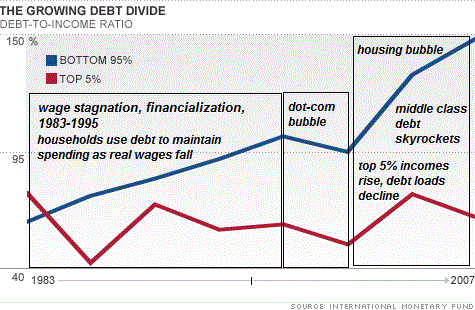
The essence of debt serfdom is debt rises to compensate for stagnant wages.
I often speak of debt serfdom; here it is, captured in a single chart. The basic dynamics are all here, if you read between the lines:
1. Financialization of the U.S. and global economies diverts income to capital and those benefitting from globalization/ “financial innovation;” income for the top 5% rises spectacularly in real terms even as wages stagnate or decline for the bottom 80%.
2. Previously middle class households (or those who perceive themselves as middle class) compensate for stagnating incomes and rising costs by borrowing money: credit cards, auto loans, student loans, etc. In effect, debt is substituted for income.
3. The dot-com/Internet boom boosted incomes across the board, enabling the bottom 95% to deleverage some of the debt.
4. When the investment/speculation bubble popped, incomes again declined, and households borrowed heavily against their primary asset, the home, via home equity lines of credit (HELOCs), second mortgages, etc.
5. The incomes of the top 5% rose enough that these households could actually reduce their debt (deleverage) even before the housing bubble popped.
To Read More CLICK HERE

